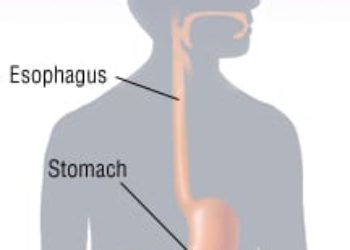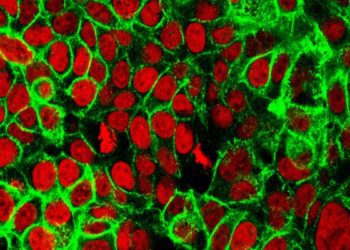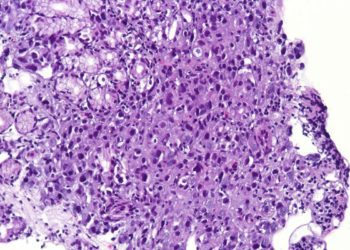Direct comparison of neoadjuvant and adjuvant chemotherapy and radiotherapy for survival outcomes from resectable gastric cancer
1. Out of the therapies that were associated with longer overall survival versus no perioperative therapy, chemotherapy with unknown timing was associated with the longest overall survival of 53.9 months.
2. Neoadjuvant chemoradiation was associated with superior decreases in pathologic complete response than neoadjuvant chemotherapy and chemotherapy with unknown timing. Neoadjuvant chemotherapy was associated with decreased positive margins compared to adjuvant chemotherapy and neoadjuvant chemotherapy with adjuvant radiation.
Evidence Rating Level: 2 (Good)
Study Rundown: Overall survival (OS) from resectable gastric cancer (RGC) is improved with perioperative chemotherapy versus surgery alone, adjuvant chemotherapy versus surgery alone, and adjuvant chemoradiotherapy versus surgery alone. However, perioperative chemotherapy, adjuvant chemotherapy, and adjuvant chemoradiotherapy have never been directly compared. This study attempts to identify the optimal treatment of RGC based on OS, pathologic complete response (pCR), and surgical margin status (SMS). The OS, pCR, and SMS of RGC patients from the National Cancer Database (NCDB) were compared by the patient’s treatment. Specifically, patients were classified as receiving only neoadjuvant chemoradiation (nCRT; n = 85), neoadjuvant chemotherapy (nCT; n = 641), adjuvant chemotherapy (aCT; n = 353), adjuvant chemoradiation (aCRT; n = 658), neoadjuvant chemotherapy and adjuvant radiation (nCTaRT; n = 112), chemotherapy with timing unknown (CTTU; n = 540), chemoradiation therapy with timing unknown (CRTTU; n = 51), radiation therapy with timing unknown (RTTU; n = 23), and no perioperative therapy (NT; n = 601). Treatment with nCRT, nCT, RTTU compared to NT was associated with an increased odds of pCR, but nCRT was superior to nCT and CTTU. An increase in the odds of positive SMS was associated with aCT and nCTaRT compared to NT and compared to nCT. Baseline sociodemographic, clinical stage, and pathology were not associated with OS. Superior OS was however associated with treatment with nCRT, CTTU, aCT, aCRT, nCT, and nCTaRT compared to NT. The treatment with the longest OS (53.9 months) and percentage of patients surviving 2-years (65.6%) was CTTU. CTTU was superior to nCT, nCRT, and aCRT on pairwise analysis. RTTU had inferior OS (4.2 months) compared to NT (12.3 months). Since selection for the treatment was based on patient factors like age, fitness, and tumour characteristics, there is a high risk that the more fit patients who would always have had the best OS are selected for more aggressive treatment; thus, no causative information can be drawn from this retrospective cohort study. Additionally, the sample size is limited when the cohort is so divided into 9 different treatment pathways. Finally, this study excluded non-surgical candidates, which would include those who progressed after starting neoadjuvant therapy, introducing a risk of overestimating the effects of treatment.
Click to read the study in JAMA Network Open
Relevant Reading: Benefit of adjuvant chemotherapy for resectable gastric cancer: a meta-analysis
In-Depth [retrospective cohort]: Gastric cancer patients with adenocarcinoma histology of stage cT2-T4b, any N, or M0 who underwent surgical resection were eligible. OS, pCR, and SMS were collected from the National Cancer Database (NCDB) and compared by patient treatment group on multivariate and pairwise analysis. 3064 patients (mean age = 68, 57.6% male, 20.7% Black, 48.9% White, 54.15% treated at an academic facility) with RGC were included in this analysis. Most patients included were stage 2 (50.2%), T3 (48.7%), and N0 (63.1%). Increased odds of pCR was associated with tumour stage (T2 vs T4: odds ratio [OR] = 3.70, 95% CI = 1.16-11.80, P = 0.03), positive nodal involvement (OR = 2.03, 95% CI = 1.05-3.92; P = 0.04), and nCRT (OR = 59.55, 95% CI = 10.63-333.56, P < 0.001), nCT (OR = 14.60, 95%CI = 2.81-75.73, P = 0.001), RTTU (OR = 29.94, 95% CI = 2.92-307.01, P = 0.004) treatment group compared to NT treatment group on multivariate analysis. nCRT was superiorly associated with pCR compared with nCT (OR = 4.08, 95%CI = 1.92-8.69; P = 0.005) and CTTU (OR = 30.78, 95% CI = 7.56-125.30, P < 0.001). Decreased odds of positive SMS was associated with earlier tumor stage (T2 vs T4: OR = 0.51, 95% CI = 0.38-0.70, P < .001), node negativity (OR = 1.27, 95% CI = 1.04-1.56, P = 0.02). There was an association between increased positive SMS and later clinical stage (Stage 3 vs 1: OR = 1.81, 95% CI = 1.27-2.58, P = 0.001), and higher grade (Grade 3 vs 1: OR = 6.20, 95% CI = 2.02-19.02, P = 0.001) on multivariate analysis. Increased odds of positive SMS, compared to NT and nCT, was associated with aCT (vs NT: OR = 1.46, 95% CI = 1.03-2.05, P = 0.032; vs nCT: OR = 1.76, 95% CI = 1.25-2.48, P = 0.047) and nCTaRT (vs NT: OR = 2.04, 95% CI = 1.27-3.26, P = 0.003; vs nCT: OR = 2.46, 95% CI = 1.54-3.91, P = 0.006). Improvement in OS was associated with nCRT (hazard ratio [HR] = 0.48, 95% CI = 0.35-0.66, P < 0.001), CTTU (HR = 0.41, 95% CI = 0.35-0.48, P < 0.001), aCT (HR = 0.52, 95% CI = 0.43-0.62, P < .001), aCRT (HR = 0.55, 95% CI = 0.48-63, P < 0.001), nCT (HR = 0.61, 95% CI = 0.53-0.71, P < 0.001), and nCTaRT (HR = 0.67, 95% CI = 0.52-0.87, P = 0.003) compared with NT. CTTU was associated with the longest OS (53.9 months, 95% CI = 44.5-61.0 months), highest 2-year OS rate (65.6%, 95%CI = 61.3%-69.5%) and was superior to nCT (HR = 0.66, 95% CI = 0.56-0.78, P < 0.001), nCRT (HR = 0.61, 95% CI = 0.46-0.79, P = 0.007), and aCRT (HR = 0.74, 95% CI = 0.63-0.87, P = 0.009). RTTU had the shortest OS (4.2 months, 95% CI = 2.5-18.6 months), which was inferior to NT (12.3 months, 95% CI = 10.4-14.6 months).
Image: PD
©2021 2 Minute Medicine, Inc. All rights reserved. No works may be reproduced without expressed written consent from 2 Minute Medicine, Inc. Inquire about licensing here. No article should be construed as medical advice and is not intended as such by the authors or by 2 Minute Medicine, Inc.







